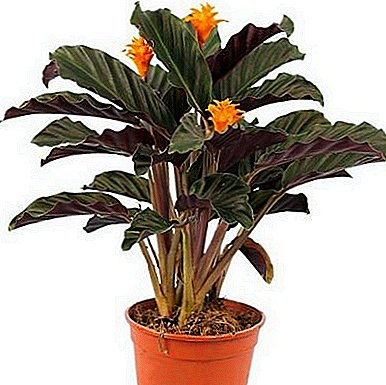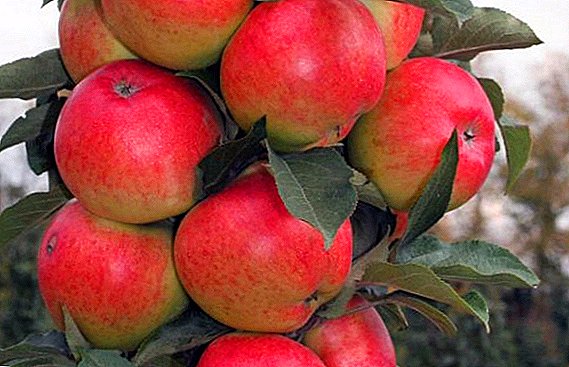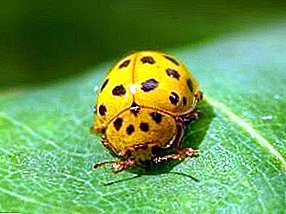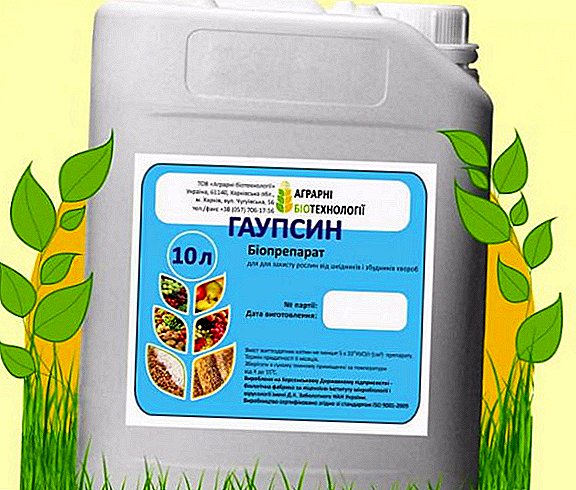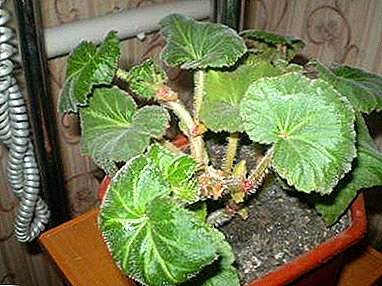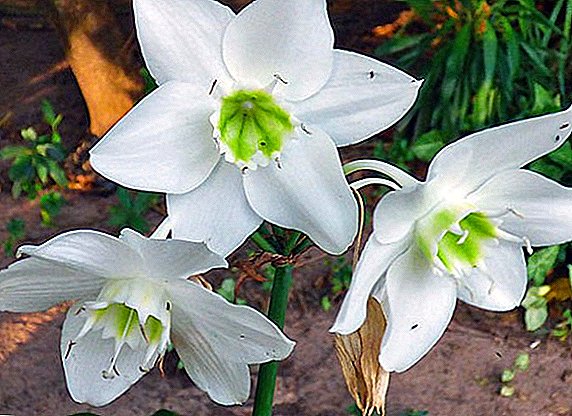 Euharis is a very common in our country houseplant with large glossy leaves of rich dark green color. But the impression that enormous snow-white (sometimes yellowish), a little eukharis flowers, a bit like delicate daffodils, decorating the plant in a skilled grower, produce a rich bunch of flowers, cannot be compared with anything!
Euharis is a very common in our country houseplant with large glossy leaves of rich dark green color. But the impression that enormous snow-white (sometimes yellowish), a little eukharis flowers, a bit like delicate daffodils, decorating the plant in a skilled grower, produce a rich bunch of flowers, cannot be compared with anything!
The native land of euharis is the tropical forests of Central and South America, primarily Colombia and the western part of Amazonia. From here came the second name of the plant, which is used by the British and under which it is better known in our area - the Amazonian lily.
Did you know? To call an euharis Amazonian lily is not entirely true, since by plant arrangement the plant is more likely to be narcissus than lily. From the Greek Eucharis can be translated as "full of grace," "charming" - so this name is much more in line with the plant.
In European countries, euharis began to grow as a houseplant in the nineteenth century, and since then the flower has not lost its deserved popularity. Euharis blooms with good care twice a year, throwing several (from one to eight, depending on the conditions of detention) long peduncles, each of which adorns a bunch of 4-6 luxurious flowers that bloom one after the other. The total period of flowering euharis lasts up to three weeks, each flower stays fresh for about a week. All this time, the plant is shrouded in the finest aroma, completely uncharacteristic of most potted flowers. Blooming euharis in the cold season, when other plants are at rest, looks like a real Christmas miracle!  Those who want to grow this beauty on their own windowsill should know how to properly care for the Amazonian lily in order to fully enjoy the beauty of its amazing colors.
Those who want to grow this beauty on their own windowsill should know how to properly care for the Amazonian lily in order to fully enjoy the beauty of its amazing colors.
Optimal conditions for euharis
Surprisingly, many fans of indoor plants, growing on the window sills Amazonian lily, do not even know that this plant should bloom. The answer to the question why euharis does not bloom at home is always in the wrong care of the plant, failure to comply with the requirements for lighting, watering, feeding, choosing the wrong pot and ignoring some other features to which this flower is especially susceptible.
Location and lighting
Euharis cannot be called a light-loving plant, but absolute shadow is also a bad option. The flower feels good in partial shade and in bright light, but the plant does not like direct sunlight. The best place for euharis is the western or eastern sill. Windows facing north are also quite suitable as a place for a pot, but on condition that at least a minimal amount of light will be provided to the euharis. During the flowering period, the plant needs more light than during the period of growth and rest.
Important! Direct sunlight is very harmful for euharis leaves, especially in summer. Therefore, if the plant is located at the windows facing south, it is necessary to provide him with protection against possible burns.
Temperature conditions
 Euharis is a heat-loving plant and, moreover, does not tolerate temperature fluctuations. The room where the plant is located should not be cooler than +16 ° C, but during the growth period it is desirable that the air be at least a couple of degrees warmer, and in order for the plant to bloom, the temperature must be 4-6 higher degrees
Euharis is a heat-loving plant and, moreover, does not tolerate temperature fluctuations. The room where the plant is located should not be cooler than +16 ° C, but during the growth period it is desirable that the air be at least a couple of degrees warmer, and in order for the plant to bloom, the temperature must be 4-6 higher degrees
In summer, the euharis can be taken out onto open balconies, but since the plant’s homeland is the tropics, by the beginning of the cold season it is necessary to return the pot to a warm room in time so that the cool night air does not harm the flower: if the temperature drops below + 7 °, the bulbs start to rot at the euharis , and the leaves turn yellow. Growing a flower in open ground in our latitudes, as a rule, excludes flowering, or the flowers are formed too small. The reason for this is the difference between daytime and nighttime temperatures that are too noticeable for a thermophilic euharis.
Growing euharis: home care
In general, euharis is unpretentious, but it is necessary to follow certain rules for caring for it.
Watering and humidity
Proper watering is perhaps the most important condition for a good euharis development.
Important! Amazon lily is more likely to forgive the lack of watering than its excess. The stagnation of water is especially harmful for euharis, the bulb starts to rot from this, and the plant can die.However, overdrying of the soil should also not be allowed. Water for irrigation must first defend.
 In order to avoid dust settling on wide leaves, periodically they should be gently wiped with a damp soft cloth or a napkin. You can gently wash the leaves under running water, while avoiding over-wetting the soil in the pot.
In order to avoid dust settling on wide leaves, periodically they should be gently wiped with a damp soft cloth or a napkin. You can gently wash the leaves under running water, while avoiding over-wetting the soil in the pot.
During the growth period it is useful to spray the plant, but at the beginning of flowering the procedure is stopped or limited: as a result of water droplets falling on the flowers, they become covered with rusty spots and completely lose all their beauty.
When flowering ends, watering should be reduced.
Feeding euharis
Feed the plant can begin as soon as the onion has sprouted. Twice a month, euharis is fertilized with universal mixtures for flowering houseplants, or organic fertilizers alternate with mineral fertilizers, and, choosing the latter, preference should be given to those in which the nitrogen content is low.
Top dressing lasts during the growing season and until the plant blooms. After that, for several months, fertilization should be stopped.
All the details of the euharis transplant
A large number of bulbs in the pot and regular feeding of the plant leads to the most decorative appearance of the bush. It looks luxuriant and blooms profusely.
Therefore, euharis transplantation should not be done too often. The plant does not tolerate this procedure very easily and is particularly hard going through root damage. therefore It is advisable not to transplant, but to cross over the euharis, fully preserving the integrity of the earthen coma, simply by moving it to a more spacious pot.
However, if the plant is left in the same pot for more than five years, the euharis may also die due to the limited space, completely clogged with new bulbs, which simply do not have enough space for normal nutrition and development.
Euharis should be transplanted when the plant is at rest after flowering (preferably in March).
Important! It is very important to choose the right pot for euharis. For normal development and regular flowering, this plant requires limited space. Therefore, it is impossible to transplant Amazon lily into a too spacious pot!
It is best to choose a pot for euharis, which will be 2-3 cm larger than the previous diameter. It is recommended to give preference to shallow pots, the increase in the container should relate primarily to its width, rather than depth. In the lower part of the pot must be provided with several holes, which can drain excess moisture.
 The next moment is the correct selection of the soil. The soil should be very nutritious, loose and moisture-intensive. You can buy a suitable substrate in a specialty store, but you can prepare the ground for euharis and on your own. It is enough to mix peat and sand or other baking powder in equal parts, and then add the mixture to the same volume of compost or leaf soil. It is also recommended to add loam (approximately 20%) to the resulting substrate. Another option suitable for zuharis soil is composed of sheet, heather (or peat), turf soil and sand in a ratio of 3: 2: 1: 1.
The next moment is the correct selection of the soil. The soil should be very nutritious, loose and moisture-intensive. You can buy a suitable substrate in a specialty store, but you can prepare the ground for euharis and on your own. It is enough to mix peat and sand or other baking powder in equal parts, and then add the mixture to the same volume of compost or leaf soil. It is also recommended to add loam (approximately 20%) to the resulting substrate. Another option suitable for zuharis soil is composed of sheet, heather (or peat), turf soil and sand in a ratio of 3: 2: 1: 1.
When the tank is picked up, the ground has been prepared and a suitable phase of plant development has begun, you can begin to carefully transplant the euharis.
At the bottom of the pot is placed a drainage layer (for example, expanded clay), on top - a layer of prepared soil. This layer is easy to calculate if you know how deep the euharis should be planted: as a result of planting, the bulbs should be 3-4 cm deep in the soil (if the bulbs are not germinated, it is allowed to leave the top above the ground, so the growth process will be easier to observe).
Then, the euharis is removed from the pot (for a start, you can gently loosen the earthen clod around it, making it easier to get it) and it is rolled over into a new one, while the plant is carefully supported at the base. After that, the required amount of soil is poured into the pot, and the soil is tightly tamped down.
Important! Separating the bulbs from the old plant is only necessary if it is propagated. With a normal transplant, it is better not to disturb the earthball: the single bulbs of the euharis grow very slowly, and flowering does not begin soon.After planting, the plant should be watered as little as possible so as not to damage the bulbs that have not yet hardened. The lack of moisture should be compensated by heavy and frequent spraying.
Euharis: features of care after flowering
After flowering, euharis needs to ensure a complete rest phase, which lasts about one and a half months. It was at this time that the plant collects strength for future growth and flowering. Therefore, the intensity of its development in the next season directly depends on the care provided by the Amazon lily at this time.
So, when the last flower has dried up, the flower stalks should be cut (leaves should not be cut off). Then the plant can be moved to a less warm place and dramatically reduce watering. Feeding and spraying during this period should not be carried out at all.
In the resting phase, sometimes the leaves start to turn yellow at euharis. It should not be frightened, the green mass in speed will be restored.  The end of the dormant period is indicated by the appearance of young leaves from the soil. Once this has happened, you can again begin to water and fertilize the euharis, and, if necessary, raise the temperature to a higher one.
The end of the dormant period is indicated by the appearance of young leaves from the soil. Once this has happened, you can again begin to water and fertilize the euharis, and, if necessary, raise the temperature to a higher one.
Did you know? Sometimes flower growers manage to achieve three-time flowering of euharis during the year. In this case, the rest periods of the plant should also be three.
Euharis, who is at rest, looks just as attractive as in the period of growth. It is not necessary to move the plant to coolness, it is only important to reduce watering and stop feeding.
Harmful insects and possible euharis diseases
The most unpleasant pests for euharis are the scale insect, Putinite mite, thrips, and powdery worm.
 Shchitovka usually affects the plant, located in too dry room, so the best measure to prevent infection is a regular spraying of the leaves.
Shchitovka usually affects the plant, located in too dry room, so the best measure to prevent infection is a regular spraying of the leaves.
This small pest, covered with a wax shell, like a shield, sucks the sap from the leaves, as a result of which they begin to dry out. It is very difficult to see the shield with the naked eye, only the results of its vital activity are noticeable. However, armed with a magnifying glass, you can find the smallest pest, very quickly moving around the plant. If an enemy is identified, treatment is much easier.
At an early stage, the large leaves of the euharis are rubbed well enough with a sponge moistened with soapy water. But if the disease is prolonged, it is worth treating the plant with the Aktara solution and, if necessary, repeat the procedure every other day. Especially carefully spray the inside of the leaf, as it is on it usually inhabits the pest.
Appearance thrips also provoked by low humidity, especially at too high temperatures. The disease manifests itself as small spots on the leaves, which later merge into a large array. The danger of thrips on the euharis is additionally related to the fact that this pest is a carrier of various diseases, and at the same time some of them are practically not treatable. Therefore, at the first sign of damage, the plant should be immediately treated with an insecticide.
 Mealybug manifests itself in the formation on the leaves of white lumps, similar to cotton, spider mite - in the appearance of spider webs between the leaves and multi-colored spots on the leaves. Pest control measures - insecticide treatment.
Mealybug manifests itself in the formation on the leaves of white lumps, similar to cotton, spider mite - in the appearance of spider webs between the leaves and multi-colored spots on the leaves. Pest control measures - insecticide treatment.
In essence, all the parasites described above are particularly easy to infect a plant in a dry room. Proper care and regular humidification of the air will help to avoid infection, and if the signs of the disease still appear, it is not necessary to identify a specific type of pest, since a properly chosen insecticide can effectively deal with any of the possible enemies of the euharis.
Problems in the cultivation of euharis
Amazon lily does not cause much trouble in the care. However, sometimes certain problems still arise. Consider the most common ones.
If the euharis does not bloom, this may be due to improper temperature conditions, too large a pot, or failure to provide the plant with a proper rest period. In addition, for flowering, the euharis bulb must be sufficiently developed, sometimes it takes up to five years.
If the euharis loses leaves for no apparent reason, this can also be explained by unfavorable temperature conditions or improper watering (excess or lack of moisture). A small amount of dried leaves does not indicate a problem; it is worth worrying if the phenomenon is constant, especially if dark spots appear on the leaves before they die.
If the leaves of euharis are covered with long red spots, it is a red burn. It is necessary to combat this specific fungal disease by removing the damaged parts of the plant (leaves and peduncles) and the subsequent treatment of euharis with copper sulphate or other copper-containing fungicide.  The reason for the rotting of the bulb can be either stagnant water in the root system, or the so-called narcissus fly, also known as the hover. It is best to fight this pest in a preventive way, before planting the bulb in the ground. To do this, just hold the bulb for three hours in hot water (about 45 degrees), then dry well. A more reliable method - soaking the bulbs in a solution "Aktellika" or drug "BI-58".
The reason for the rotting of the bulb can be either stagnant water in the root system, or the so-called narcissus fly, also known as the hover. It is best to fight this pest in a preventive way, before planting the bulb in the ground. To do this, just hold the bulb for three hours in hot water (about 45 degrees), then dry well. A more reliable method - soaking the bulbs in a solution "Aktellika" or drug "BI-58".
Plants afflicted with narcissus fly are usually recommended to be dug out and burned, since control is considered ineffective. However, if you throw the plant miserably, you can put it in quarantine, removing it from the neighboring indoor plants, and try out some popular recommendations for saving the flower.
Did you know? It is believed that the narcissus fly can be disposed of by abundantly sprinkling the base of the plant with powder of fir flour, which can be purchased at some pharmacies. It is recommended to pour the same flour with hot water, insist a few hours and spray the plant. Another radical method is watering the plant under the root with water, in which the ground tablet of the drug Trichopol is dissolved (1 piece per 1 liter of water). The third option - watering the plant with a cool saline solution - may destroy the pest, but also threatens the plant itself, since the soil after such treatment becomes of little use for the Amazon lily.
Whatever the problem, it is important to correctly establish its cause and take measures to correct the care of the plant, and then the development of the euharis will quickly normalize ...
Reproduction of euharis at home
Euharis is a bulbous plant, therefore its reproduction is carried out by dividing a bush (by separating young onions).  Completely isolated onions are very carefully separated from the mother plant and transplanted into separate pots. The space for the plant should be minimal, so it is better to plant several bulbs in one pot than to give the Amazon lily too much free space in the container. The soil at planting should be sufficiently wet, but not “float”. The first 10 days after planting the plant should not be disturbed by irrigation, feeding, or other procedures.
Completely isolated onions are very carefully separated from the mother plant and transplanted into separate pots. The space for the plant should be minimal, so it is better to plant several bulbs in one pot than to give the Amazon lily too much free space in the container. The soil at planting should be sufficiently wet, but not “float”. The first 10 days after planting the plant should not be disturbed by irrigation, feeding, or other procedures.
Young bulbs usually germinate in one and a half - two months after planting.
If the planting is too close, the euharis develops slowly, but on the other hand, a large number of bulbs in the pot provides the most lush shrub and effective long-term flowering. In addition, a single transplanted bulb will not begin to bloom before it has acquired a sufficient number of "babies." Therefore, without exaggeration, we can say that the optimally selected number of bulbs per pot volume is the main guarantee that after planting the Amazon lily will quickly take shape and start to please the florist with amazingly beautiful flowers.


